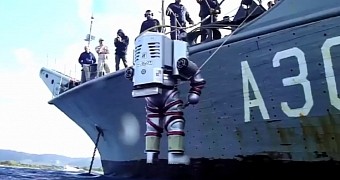Divers have to be careful not to swim too deeply or too long, and to make sure they surface slowly, in order to avoid suffering from decompression sickness too much. A new exosuit will eliminate that problem entirely though.
Decompression sickness, or diver's sickness, can have many symptoms, from joint pain and rashes to paralysis and death.
It stems from dissolved gases coming out of solutions into bubbles inside the body. The effects depend on where the bubbles migrate in the body.
Needless to say, professional divers need to go through training to make sure they don't surface too fast, and decompression methods are used for other situations where this sickness may arise.
However, this also means that divers can only spend a limited amount of time at significant depths, since they need to dedicate a fair chunk of their air supply to the steady ascent back to the surface.
New exosuit eliminates the risk of decompression sickness
If you haven't heard of the Antikythera wreck, you're about to. It is a ship around 2000 years old that was discovered at the bottom of the Aegean Sea in 1900.
Some statue fragments, jewelry and the Antikythera mechanism have since been retrieved, the mechanism being the most important, an astronomical calculator considered by many to be the world's oldest computer.
However, many artifacts and other treasures are believed to remain at the site, since odds are high that the ship was full of loot from Greece. Loot that was being taken to Rome during the time of Julius Caesar.
Underwater archaeologists are preparing to embark on a new salvage operation, and they are going to use the chance to give the new Exosuit a trial by fire, however unsuitable that metaphor is.
A test has already been performed. The robotic suit was lowered in the Vatika Bay, near the Greek Island of Antikythera, over the course of this weekend.
Now, divers are ready to don the 240-kilo (530-pound) suit and spend hours upon hours at a depth of 60 meters / 200 feet, looking for hidden relics. Four 1.6-horsepower thrusters allow for up, down, forward and backward movement, as well as left and right strafes.
The retrieval mission is being hampered by nature
The “mission” was supposed to begin back in September, but it had to be postponed because of storms. Hopefully, the weather won't work against the team anymore. Also, since 3D digital maps of the shipwreck have already been created (an underwater robot called Sirius has scanned the seafloor quite thoroughly by now), the excavation should go smoothly.

 14 DAY TRIAL //
14 DAY TRIAL // 